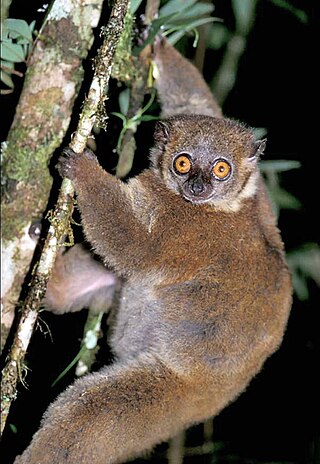Portal:Primates
Portal:Primates
 A primate is a member of the biological order Primates, the group that contains lemurs, the aye-aye, lorisids, galagos, tarsiers, monkeys, and apes, with the last category including great apes. With the exception of humans, who inhabit every continent on Earth, most primates live in tropical or subtropical regions of the Americas, Africa and Asia. Primates range in size from the 30-gram (1 oz) pygmy mouse lemur to the 200-kilogram (440 lb) mountain gorilla. According to fossil evidence, the primitive ancestors of primates may have existed in the late Cretaceous period around 65 mya (million years ago), and the oldest known primate is the Late Paleocene Plesiadapis, c. 55–58 mya. Molecular clock studies suggest that the primate branch may be even older, originating in the mid-Cretaceous period around 85 mya. Primates exhibit a wide range of characteristics. Some primates do not live primarily in trees, but all species possess adaptations for climbing trees. Locomotion techniques used include leaping from tree to tree, walking on two or four limbs, knuckle-walking, and swinging between branches of trees (known as brachiation). Primates are characterized by their large brains relative to other mammals. These features are most significant in monkeys and apes, and noticeably less so in lorises and lemurs. Many species are sexually dimorphic, which means males and females have different physical traits, including body mass, canine tooth size, and coloration.
Mesopropithecus is an extinct genus of small to medium-sized lemur, or strepsirrhine primate, from Madagascar that includes three species, M. dolichobrachion, M. globiceps, and M. pithecoides. Together with Palaeopropithecus, Archaeoindris, and Babakotia, it is part of the sloth lemur family (Palaeopropithecidae). As it had the shortest forelimbs of all sloth lemurs, it is thought that Mesopropithecus was more quadrupedal and did not use suspension as much as the other sloth lemurs. They are known only from subfossil remains and died out after the arrival of humans on the island, probably due to hunting pressure and habitat destruction. Mesopropithecus was one of the smallest of the extinct subfossil lemurs, but was still slightly larger than the largest living lemurs. Although rare, the three species were widely distributed across the island yet allopatric to each other, with M. dolichobrachion in the north, M. pithecoides in the south and west, and M. globiceps in the center of the island. All three species were primarily a leaf-eaters (folivores), but also ate fruit and seeds.
 The white-fronted capuchin, Cebus albifrons, is a species of capuchin monkey, a type of New World primate, found in seven different countries in South America: Bolivia, Brazil, Colombia, Venezuela, Ecuador, Peru, and Trinidad and Tobago. The species is divided into several different subspecies, though the specific divisions are uncertain and controversial.  Data Deficient (IUCN 3.1)|Data Deficient The small-toothed sportive lemur (Lepilemur microdon), or small-toothed weasel lemur, is a primate species in the family Lepilemuridae that—like all lemurs—is endemic to Madagascar. The species lives in dense rainforest in southeastern Madagascar, and can be found in Ranomafana National Park and Andringitra National Park. As its name implies, some of its teeth are smaller than those in other sportive lemurs. It is relatively large for a sportive lemur, and is difficult to visually distinguish from the weasel sportive lemur. The species weighs between 0.9 and 1.2 kg (2.0 and 2.6 lb) and measures 55 to 64 cm (22 to 25 in) from head to tail. Its fur is mostly reddish-brown or chestnut color, with a dark stripe running from its head down its back. Its underside and neck are lighter in color. Like other sportive lemurs, it is nocturnal, sleeping in concealed tangles of vegetation as well as tree holes. The small-toothed sportive lemur is solitary and eats leaves, fruits, and flowers. Due to recent taxonomic changes and a lack of clarity about its population size and range, it is listed as "Data Deficient" by the International Union for Conservation of Nature (IUCN). It is also protected from international commercial trade under CITES Appendix I. Its primary threats are habitat loss to slash and burn agriculture and hunting. 

Discover Wikipedia using portals |
















